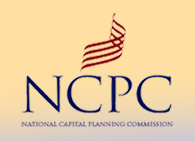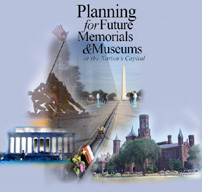Memorials and MuseumsThe memorials and museums that define Washington's monumental core express America's connections to its past and its direction for the future. From the Washington Monument and the Holocaust Museum to the Tomb of the Unknown Soldier and the Frederick Douglass Home, Washington's cultural and commemorative spaces are physical reminders of our collective past and repositories for our most precious artifacts. How and where we honor our heroes and display our national treasures are matters of great importance to all Americans. As the demand for new memorials and museums in our nation's capital continues to increase, there are growing concerns that unabated construction of these attractions will overwhelm the historic open space in the traditional monumental core. NCPC, the U.S. Commission of Fine Arts, and the National Capital Memorial Advisory Commission are the three federal agencies responsible for the location and design of new commemorative works on federal land. In 1997, Congress directed the National Capital Planning Commission to develop a master plan in consultation with the other two review bodies. The resulting Joint Task Force explored the issues affecting future memorials and museums and recruited a team of nationally recognized planning and design professionals to offer creative approaches to the master plan work. In addition, the Joint Task Force consulted with numerous local business, community, and professional groups in the preparation of the plan.
Central to the Memorials and Museums Master Plan is the Commemorative Zone Policy, adopted in 2000. The policy designated three commemorative zones. They are the Reserve, or the central cross-axis of the Mall where no new memorials should be built; Area I, which is designated for commemorative works of preeminent historic and national significance; and Area II, the remainder of the city, where development of new memorials and museums should be encouraged. The Memorials and Museums Master Plan ensures that future generations of Americans will have a sufficient supply of preeminent sites for their museums and memorials. In addition to identifying 100 potential sites for future memorials and museums, the master plan provides general guidelines, siting criteria, and implementation strategies. This plan also includes inventories of existing memorials and museums and a forecast of future requirements. A central feature of the master plan is an urban design framework for locating future sites. This framework is based on historic planning influences, urban design considerations, and current planning and development initiatives. The plan also includes the policies that will guide federal agencies in their review of future commemorative works and museums. To date, the plan has guided site selection for five new commemorative works including the Air Force Memorial and the Victims of Communism Memorial. The draft Memorials and Museums Master Plan was released on December 15, 2000, and the public comment period ran until March 2, 2001. Task force members heard public testimony preceding and following the release of the draft plan. At its public meeting on September 6, 2001, the Commission unanimously approved the master plan. The National Capital Memorial Commission endorsed the plan on August 30, 2001, and the Commission of Fine Arts approved the plan at its meeting on September 20, 2001. In November 2003, Congress passed Public Law 108-26, which gave the weight of law to an expanded version of NCPC's proposed Reserve. In August 2006, NCPC adopted an amendment to its Memorials and Museums Master Plan. The amendment removed four potential sites from eligibility because they were in the expanded Reserve created by Congress. These four sites are:
The Memorials and Museums Master Plan (in three parts) and the Joint Task Force’s Report on the Master Plan can be viewed electronically (see below). To obtain a hard copy of the Memorials and Museums Master Plan, please contact NCPC at 202-482-7200 or info@ncpc.gov. Memorials and Museums Master Plan, pp. 1-33 Memorials and Museums Master Plan, pp. 34-99 Memorials and Museums Master Plan, pp. 100-169 Report of the Joint Task Force Technical Amendment to the Memorials and Museums Master Plan
|
401 9th Street, NW
North Lobby, Suite 500
Washington D.C. 20004
Phone: (202) 482-7200
Fax: (202) 482-7272
Email: info@ncpc.gov
North Lobby, Suite 500
Washington D.C. 20004
Phone: (202) 482-7200
Fax: (202) 482-7272
Email: info@ncpc.gov



 The
The